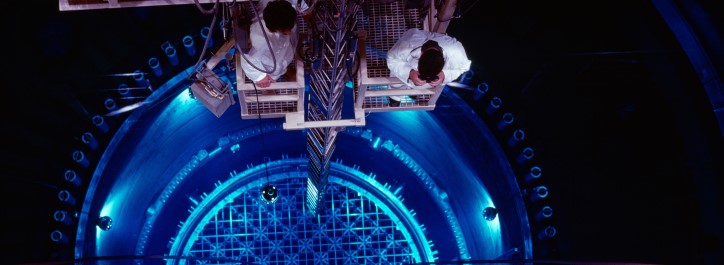FENNECS: Simulating the neutron-physical behaviour of complex reactor cores

Researchers worldwide are working on small modular reactors (SMR) and microreactors (very small modular reactor, vSMR). Many of these new reactor concepts are being developed for specific applications and have special core geometries. In order to be able to simulate the neutron-physical behaviour of these cores, GRS is developing the simulation code FENNECS (Finite ElemeNt NEutroniCS).
Small reactor modules with special core configurations
SMRs place fewer demands on the site and can therefore be deployed more flexibly than conventional nuclear power plants. Thus, SMRs can be used to supply remote cities and industrial plants with electricity and heat. Some of these concepts are already being realised in some countries. Example projects are the floating Russian small power plant Akademik Lomonosov or the CAREM under construction in Argentina and the ACP-100 under construction in China. Others are in advanced planning stages, including the SMR concept of NuScale (USA), in which several reactor modules are arranged in a common water basin for emergency cooling.
With the smaller core geometries of SMRs, however, the neutron kinetics simulation codes developed and established for large reactor cores can reach their limits. It becomes even more obvious with microreactors, which are e. g. intended in the military or as propulsion systems for ships and in space travel. Their reactor cores have completely new geometries and configurations and are cooled with alternative media (e.g. liquid potassium). One example of this is horizontal configurations cooled by heat pipes.
With the development of FENNECS, GRS creates the conditions for being able to assess the three-dimensional core behaviour of SMRs and vSMRs both in operation and in case of disturbances or under accident conditions in a safety-related and independent manner.
Basis: finite-element method
In FENNECS, the finite element method (FEM) is used to solve the diffusion equations. Here, the core is divided into a finite number of elements ("spatially discretised") that can be well adapted to complex core geometries thanks to variable size and shape. The neutron-kinetic behaviour of each of these elements and the interactions of neighbouring elements are then calculated.
Increased benefit through further development

Top row: Radial section through the core of a microreactor with control rod drums turned out (left) and turned in (right), Bottom row: Associated neutron flux distributions calculated with FENNECS (red: high flux, blue: low flux)Top row: Radial section through the core of a microreactor with control rod drums turned out (left) and turned in (right), Bottom row: Associated neutron flux distributions calculated with FENNECS (red: high flux, blue: low flux)Innovative core geometries can also contain moving components, e.g. rotating control rod drums. In order to take these and other time-dependent effects into account, FENNECS has been extended accordingly. Furthermore, the code is coupled with the thermohydraulics code ATHLET (part of the GRS code system AC2), so that the retroactive effect of temperature effects on the neutron kinetics is also recorded. In addition, GRS is currently developing PEMTY (Python External Meshing Tool for Yaml input), a separate tool that handles the discretisation of an irregular core, which is required as input for FENNECS.
First successful applications and outlook
Early versions of FENNECS were successfully tested on two advanced reactor concepts with regular core geometries (based on a code-to-code comparison for the sodium-cooled concept ASTRID and in the OECD/NEA benchmark for the gas-cooled high-temperature reactor MHTGR). The current code version was convincing i.a. in a research project of the International Atomic Energy Agency (IAEA) on the China Experimental Fast Reactor (CEFR). In another research project, the simulation of a microreactor developed by Argonne National Laboratory (USA) was carried out. Current work focuses on the further development as well as on the verification and validation of FENNECS and PEMTY.
Publications
- Seubert, A 3-d Finite Element Few-group Diffusion Code and its Application to Generation IV Reactor Concepts, PHYSOR 2020: Transition to a Scalable Nuclear Future, Cambridge, United Kingdom, March 29th-April 2nd, 2020 (https://www.epj-conferences.org/articles/epjconf/abs/2021/01/epjconf_physor2020_02010/epjconf_physor2020_02010.html).
- J. Bousquet, A. Seubert and R. Henry, New finite element neutron kinetics coupled code system FENNECS/ATHLET for safety assessment of (very) Small and Micro Reactors, J. Phys.: Conf. Ser. 1689 012008, 2020 (https://iopscience.iop.org/article/10.1088/1742-6596/1689/1/012008).
- Paper by ANL: https://www.anl.gov/nse/microreactor-design-and-analysis
Links
- INL webpage on microreactors: https://inl.gov/trending-topic/microreactors/
- ANL webpage: https://www.anl.gov/nse/microreactor-design-and-analysis
- Webpage on NuScale: https://www.nuscalepower.com/
- Webpage on CAREM: https://www.argentina.gob.ar/cnea/carem
Sven Dokter
GRS
Sven.Dokter@grs.de